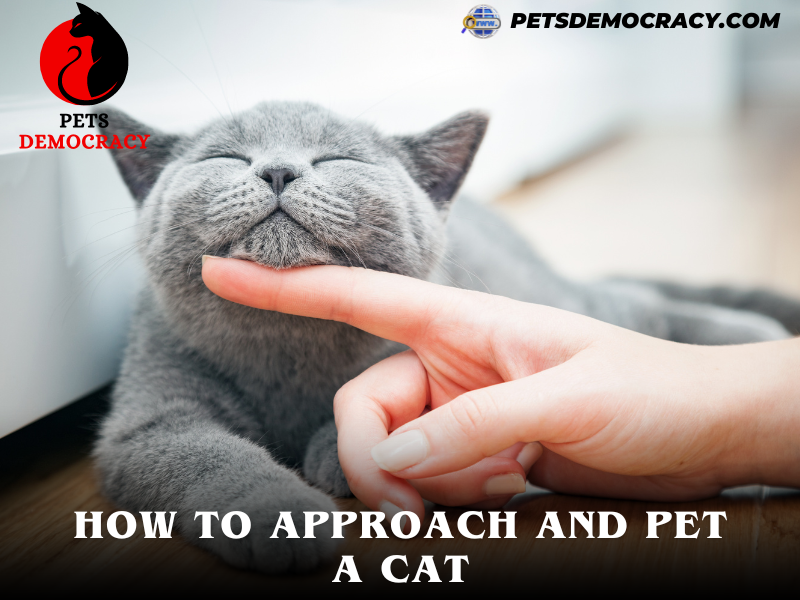
Understanding how to pet a cat involves recognizing their need for personal space and realizing that not all moments are right for affection. By earning a cat’s trust, and allowing them to sniff your hand first, you pave the way for a more receptive and enjoyable petting experience.
Always petting a cat in the direction of their fur ensures comfort and promotes a positive interaction; it’s just one of the essential tips for mastering how to pet a cat properly.
This guide will not only cover the best places to pet a cat but also how to recognize signs of overstimulation to ensure your feline friend remains comfortable and happy.
Understanding Cat Body Language
Understanding pet a cat body language is crucial to fostering a comfortable and enjoyable interaction for both you and your feline friend. Here’s a breakdown of key signals to watch for:
Positive Signs
- Approach Indicators: Cats showing their belly or giving a slight head bump are signs of trust, though the belly display isn’t an invitation for a rub.
- Affectionate Actions: Purring, slow blinking, and kneading indicate contentment and approval. If your cat initiates contact or gently bunts you, it’s a green light to continue petting.
Signs of Discomfort or Overstimulation
- Visual and Auditory Cues: Be cautious of hissing, growling, or a high-pitched meow, which indicate distress or discomfort.
- Physical Movements: Watch for a tail flicking rapidly, ears flattening, or pupils dilating, as these are clear signs your cat may need a break.
General Observations
- Observing Body Posture: A relaxed posture and forward-facing ears show a confident and comfortable pet a cat, while crouched or tense body language suggests anxiety or fear.
- Interaction Responses: Monitor how your cat responds to petting; if they seem to freeze or their ears flatten, consider adjusting your technique.
By paying attention to these cues and respecting your cat’s space, you can ensure a positive experience that strengthens your bond.
Where Do Cats Like to Be Petted?

Preferred Petting Spots for Cats
When interacting with a cat, knowing the right spots to pet can enhance the bonding experience. Here’s a guide on How to Pet a Cat:
- Head and Neck: Cats often enjoy petting on the head and neck. Focus on areas like the back of the head, forehead, and under the chin. Gently scratching under the chin can particularly send them into a blissful state.
- Cheeks and Ears: Petting on the cheeks and behind the ears is usually welcomed because these areas contain scent glands. This not only feels good to them but also allows them to mark you with their scent.
- Back: A smooth stroke along the back from the head to the tail is typically enjoyed, but avoid the tail itself. Most cats prefer soft, gentle strokes moving in the direction of their fur.
Areas to Avoid
- Belly: The belly is a common no-touch zone. Cats may show their belly as a sign of trust, but this doesn’t necessarily mean they want it touched. Touching the belly can lead to an adverse reaction.
- Tail and Feet: Avoid petting the cat on the tail, legs, and feet. These areas are sensitive and many cats dislike being touched there.
By respecting these preferences and observing your cat’s reactions, you can ensure a pleasant experience for both you and your cat.
How to Approach and Pet a Cat

Approaching and petting a cat requires understanding and patience to ensure the interaction is positive for both you and the cat. Here are the key steps to follow:
- Initial Approach:
- Always allow the cat to make the first move.
- Sit on the floor to be at the cat’s level and avoid towering over them, which can be intimidating.
- Extend a hand slowly at the cat’s eye level and let them come to you for a sniff; this gesture shows respect for their space and comfort.
- Petting Technique:
- Start by petting areas where cats generally like to be touched, such as the head, neck, or base of the tail. Use gentle strokes in the direction of the fur to keep them comfortable.
- Observe the cat’s reaction as you pet them. Signs of enjoyment include purring, kneading, or leaning into your hand.
- Be cautious with areas like the belly and feet, as many cats are sensitive about being touched here.
- Monitoring and Adjusting:
- Watch for any signs of overstimulation, such as tail swishing, skin twitching, or ears flattening. These signs indicate it’s time to stop petting.
- If the cat shows any discomfort, pause and give them some space. You can try again later once they seem more relaxed.
- Remember, each cat is unique. What works for one might not work for another, so it’s important to adapt based on the individual cat’s preferences and responses.
By following these guidelines, you can ensure a respectful and enjoyable interaction that helps build trust and affection between you and the cat.
Recognizing Signs of Overstimulation
Recognizing signs of overstimulation in cats is essential for maintaining a harmonious interaction. Here are some key indicators and strategies to manage overstimulation:
- Signs of Overstimulation:
- Restlessness, skin rippling, and ear flattening are early signs that your cat is getting too much stimulation.
- Tail thumping and nipping also indicate that it’s time to pause the petting session.
- If your cat’s body language shows any of these signs, stop petting immediately to prevent any aggressive reactions.
- Managing Overstimulation:
- Keep petting sessions brief, ideally under a minute, to avoid overstimulation.
- Use toys like wand toys or laser pointers during play to maintain a safe distance and reduce direct hand contact, which can lead to overstimulation.
- Schedule regular, structured playtimes to help your cat release pent-up energy and reduce stress, which can lessen the likelihood of overstimulation during petting.
- Post-Play Strategies:
- After engaging in play, offer your cat a high-protein snack to mimic the natural conclusion of a hunting sequence, which can help calm them down.
- Avoid petting your cat during or immediately after play sessions, as they might still be too excited or stimulated.
- If your cat does become overstimulated, give them space and time to calm down before attempting further interaction.
FAQs
What is the best way to pet a cat?
To pet a cat effectively, focus on areas where they have facial glands such as the base of their ears, under the chin, and around the cheeks. These spots are typically more enjoyable for cats compared to their stomach, back, or the base of their tail.
Where do cats most enjoy being petted?
Cats generally prefer being petted along their back or having their ears and chin scratched. It’s advisable to avoid touching their paws, tails, underbellies, and whiskers, as these areas are very sensitive.
Which parts of a cat’s body do they like being touched?
Pet a Cat often favors being touched on their head, shoulders, cheeks, and nose. The chin and neck are also popular spots. Be cautious with the tail, as some cats may not enjoy it and could react negatively. Observing your cat’s reactions is crucial to ensure they are comfortable.
Why do cats move around when being petted?
Cats experience a sort of sensory overload when petted, which can confuse them emotionally. This confusion causes them to move back and forth as they try to align their physical responses with the emotional input they are receiving.
Conclusion
Through the thoughtful application of the techniques and insights presented, pet owners are equipped to foster a deeper, more rewarding connection with their feline companions.
The importance of recognizing and respecting your cat’s body language and personal space cannot be overemphasized, as it forms the foundation of a trusting and affectionate relationship.
The guidance on preferred petting spots, coupled with the insights on recognizing signs of overstimulation, empowers cat owners to provide the comfort and security their pets crave, ensuring interactions are both pleasurable and stress-free.
As we aim to strengthen the bond with our furry friends through understanding and respect, remember that the journey of companionship is ongoing and filled with learning at every turn.
To further enhance your bond with other household pets and ensure every family member receives the same level of understanding and care, consider also learning how to pet a dog to sleep, offering restful and comforting moments to all your animal companions.
Together, these practices not only enrich the lives of our pets but also contribute to a harmonious and loving home environment.


